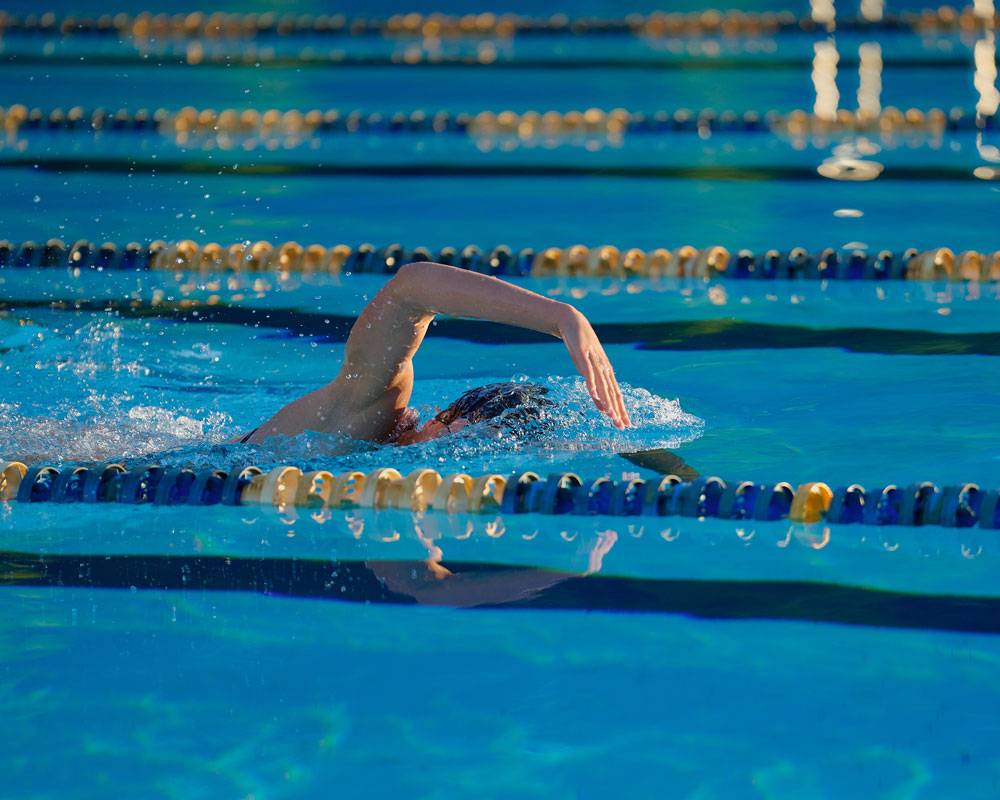The most important summarized:
|
What does a typical training day look like for a professional swimmer?
What motivates them to persevere even on the toughest days and how do they find the balance between intense training sessions and their personal lives? In this article we give you exclusive insights into the lives of professional swimmers who share their daily routines and training challenges with us. Find out how they prepare both mentally and physically for competitions and what strategies they use to integrate family, friends and hobbies into their intensive everyday lives.
What does a typical training day look like for you? How many hours are spent in the water and out?
Anja Crevar: My typical training day consists of the two swimming sessions for a little less than two hours per each session. It also includes one dryland session, depending on the day, for about one hour. It is some average for me and, of course, it also depends on the period we are in the season.

"On my typical day I spend around seven to eight hours all together at the pool/gym (my second home 😊.)"Katja Fain
Katja Fain: I usually wake up at 5:10, have breakfast, get ready and then take a walk to the pool. I am at the pool at 6:00 and my warm up routine plus getting the pool and equipment ready before training takes about 30 min. From 6:30 to 8:30 I am training in the pool and after I have another hour long gym session, so I am done for the morning at around ten o’clock. After recharging, errands, lunch, a nap… I am back at the pool at 14:30 again to warm up and get ready for another swim session from 15:00 to 17:00. Then I usually spend some time stretching, doing some mobility excerices or core. For enough sleep I go to bed between 21:00 and 21:30. So on my typical day I spend around seven to eight hours all together at the pool/gym (my second home 😊).
Tanja Stroschneider: I usually swim, bike & run every day. Makes around ten hours of swimming every week. Plus: I‘ve found my love for Hyrox recently, so I add one to two sessions of Hyrox training as well every week.
Paulina Peda: My day starting with morning training around seven am, the second training is around five pm and I have ten training sessions a week.
What's the hardest part of your training routine, and how do you push through those tough days?
Anja Crevar: The hardest parts for me are the days when you just are not "feeling it", the days when you are not into getting out of your comfort zone. But the improvement lays in exact those days, so I'm trying to recognize that feeling, be aware of it and try to adapt as much as it's possible so I can get the maximum out of it.

"The hardest parts for me are the days when you just are not "feeling it", the days when you are not into getting out of your comfort zone. But the improvement lays in exact those days, ..."
Anja Crevar
Katja Fain: The hardest parts are the days when your body is tired, sore and is just telling you it has had enough. I try to convince my mind that it’s supposed to hurt and that I can push through. I take my thoughts to my goals, dreams and what I want to achieve which helps with powering through.
Tanja Stroschneider: Getting back into a good training rhythm after a bad race. Motivation is usually low and training feels pointless. However I‘m reminding myself then, that I don’t want to have such a bad feeling again after the next race, so I motivate myself to do everything I can do to make the next race a good one again.

"The hardest thing is to give yourself permission for those weaker days, relax and let go, because such training is necessary and we are only human."Paulina Peda
Paulina Peda: I'm a perfectionist, so in my opinion everything has to be perfect and done 110%. If this doesn't happen because, for example, I don't feel well, I'm very tired, etc., I get very upset. The hardest thing is to give yourself permission for those weaker days, relax and let go, because such training is necessary and we are only human.
How do you balance the intense demands of swimming with other aspects of your life like family, friends and hobbies?
Anja Crevar: It’s hard, but it’s possible when you plan in front and make a good organization. Of course, you should also have a big support and understanding from your surroundings.
Katja Fain: I try to fill up any free time I have with spending time with my family and friends. With the intense demands of high level sport, you need to make time to also go outside of your sport, so I try to occupy my mind with different things to do that aren’t swimming now and again, just to give my mind a little break.

"It can be very difficult and is definitely a weak point of me because triathlon is so time consuming I really miss my „normal“ life quite often."Tanja Stroschneider
Tanja Stroschneider: It can be very difficult and is definitely a weak point of me because triathlon is so time consuming I really miss my „normal“ life quite often. I‘m telling myself, that what I do now is not forever and there‘s only a certain time in my life where I can do this, which makes it easier. Plus, I‘m very lucky to have very understanding & supporting family & friends.
Paulina Peda: I’m trying to reconcile everything. Between training, find time for a hobby and meet friends in the evenings or whenever you have a moment of free time.



